What the Stock Market Cycles are Saying Now!!
Stock-Markets / Cycles Analysis Mar 18, 2010 - 03:20 AM GMTBy: Jim_Curry
 Since my last article back in February, I have received a number of emails asking me for an update on the current cyclic position of the markets. While I have to reserve the most up-to-date analysis for our subscribers, in this article I am pleased to offer up my detailed comments on the current U.S. stocks indexes, and also on their relationship with the various cycles that I track.
Since my last article back in February, I have received a number of emails asking me for an update on the current cyclic position of the markets. While I have to reserve the most up-to-date analysis for our subscribers, in this article I am pleased to offer up my detailed comments on the current U.S. stocks indexes, and also on their relationship with the various cycles that I track.
With that said and noted, let’s get right into the nitty-gritty…
In my article/post from back in mid-January, I noted that several of the key mid-term cycles that I tracked were due to roll over to the downside. Those cycles were the 45-day (nominal 10-week) and 90-day (18-20 week) waves. Back then, I noted that the prior 45-day cycle target to the 1148.16 - 1172.38 SPX CASH area would act as firm resistance to that upward phase; the market peaked right into this resistance zone (1150.45 SPX CASH, on 1/19/10), and then triggered a sharp decline into the month of February with the same. The correction into the larger 90-day bottom was expected to be, at minimum, 4-5% off the top - though the statistical average was noted as closer to 6.2%.
Also back in January, we took a look at technical action - as technical non-confirmations will usually accompany mid-term cyclic tops and bottoms.
From my 1/15/10 article on the Market Oracle: (http://www.marketoracle.co.uk/Article16506.html) I wrote:
“In looking at a chart of the advance/decline line (shown above), we can see that this index is currently making new highs for the move - which tends to confirm the larger upside trend. Normally, any major price peak should see the A/D line diverging from price action - and usually in a big way. The fact that it is not doing at the present time favors that higher highs will continue to be registered with the 180 and 360-day cycles into late-Spring of 2010 - even though various corrections should be seen in-between with the smaller 45 and 90-day components - both of which are beginning to roll over. The action of the A/D line would also tend to add credence to the statistical notes regarding price with the 180-day component, which infers a potential move to the mid-to-high 1200's on the SPX before all is said and done. However, for the shorter-term action, the McClellan Summation index (bottom pane of the chart above) is showing a mild divergence from price - which will normally occur at smaller 45/90-day degree tops. In other words, the short-term technical action tends to favor that we will soon see a correction with the smaller cycles - but the larger technicals would favor that correction to give way to higher highs again into May or June of this year.”
As noted back in January, the shorter-term McClellan Summation index was diverging from price action - which was indicative of a 45 and 90-day cycle top forming. However, the fact that the larger advance/decline was confirming the action suggested that higher highs were likely to follow that 45/90-day correction. I will address the current technical state of the market in the latter part of this article.
After the decline with the 45 and 90-day cycles was underway, both the Hurst channel analysis - as well as a statistical study on patterns - offered up some additional information on what we were to expect. Back in a second article from 1/26/10 (http://www.marketoracle.co.uk/Article16776.html) I noted that taking the 1085 level out to the downside on the SPX would indicate that the 45-day cycle had seen the more bearish pattern of a ‘higher-high/lower-low’ - and that the average decline with the same was normally in the range of 8.5% off the top. This favored a move to the 1053 level or lower on this index. Below is the original forecast chart, vs. how it played out in real-time:
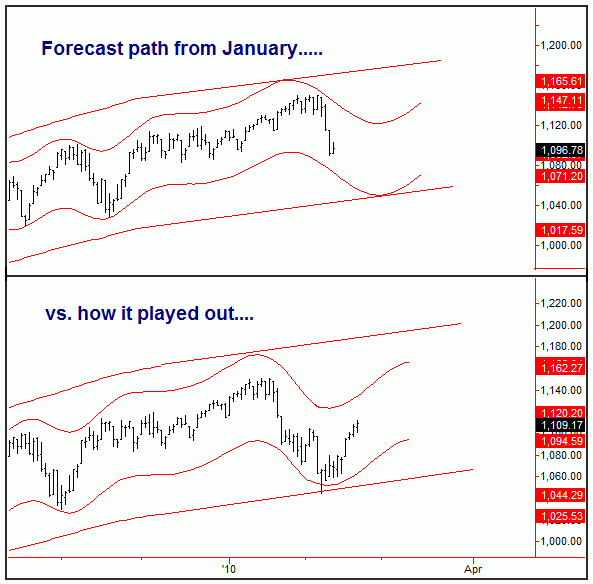
On Tuesday, 2/16/10, the SPX then confirmed a 45-day cycle bottom in place - and also confirmed an initial upside target with the same to the 1107.08 - 1118.74 range. Shortly thereafter, the index then indicated an additional upside target to the 1128.20 - 1146.80 range. The first of these targets was hit on 2/18/10, with the higher target satisfied on 3/5/10.
With the smaller 45-day cycle having registered the pattern of a ‘higher-high/lower-low’ - and then confirming a turn up with the same - there were very good-odds that the larger 90-day wave had also bottomed. This was based upon looking at past instances of this particular wave, which only occur, on average, about once per year. That is, going back over the last decade - and using the 200-day moving average (bull market) as a filter - approximately 80% of the time that the 45-day cycle had turned up from the pattern of a ‘higher-high/lower-low’, the same had signaled a mid-term bottom in place for the larger 90-day wave.
In addition to the above, the average rally with the 45-day cycle - within the above pattern - had been in the range of 9.3% or better off the bottom, which made the suggestion that the SPX would push as high as the 1143 figure or better before it topped. In terms of time, that average rally lasted 31 trading days before peaking - which suggested that this cycle would try and hold off it’s next top until on or after the third week of March (which we are now into).
With all the above then said and noted, let’s take a look at the current mid-term cyclic model, via the table below:
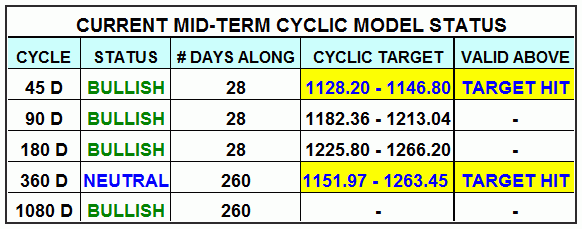
From the above table, you can see that the smallest wave - the 45-day component - is now 28 trading days along from it’s 2/5/10 bottom. Based upon the position of each of the larger waves, this 45-day cycle is expected to be very bullishly-translated to the right (which simply means a peak well past the midway point). In other words, the top for this component should still be out there somewhere, and may attempt to form sometime later this month. Here is a look at the updated Hurst cycle/channels, which encloses this 45-day wave:
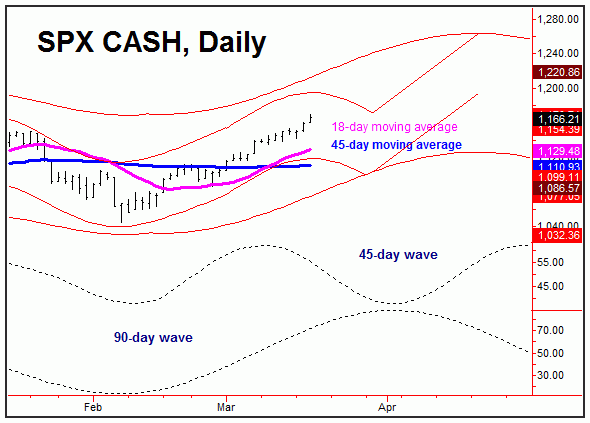
You can see on the Hurst channels that the forecast is looking for a strongly right-translated rally with the 45-day wave - and then a short decline into very early April. The one thing to note is that the channel forecast itself is looking for a bottom on the earlier side than the nominal 45-day wave actually is; the nominal wave is shown in the lower pane in dashed lines. The channel forecast is looking for an earlier low - simply based upon the fact that recent rotations of this cycle have been averaging closer to 37-38 trading days. This is due to the larger bullish trend that we are currently in. You can see that the larger channel (the one that encloses the 90-day wave) is moving firmly to the upside at the present time - and will limit any near-term downside from the smaller 45-day component.
Once the 45-day cycle does top in the next week or two, then what we should see some retracement into the next bottom for the same. In terms of time, this decline will last something like 3-5 days off the top - and should make an attempt at the 18-day moving average or lower (wherever that moving average is at the time); that decline could move as low as the blue 45-day moving average. Having said that, the actual peak for this cycle could well come from higher numbers than already seen, such as the 1180’s on the SPX, which, by the way, is also the current upside target from the larger 90-day component (to 1182.36 - 1213.04 SPX CASH).
Stepping back just a bit, you can see that the larger 90-day component is projecting higher prices into late-April or into the month May. In terms of price, as noted above there is a current upside target to the 1182.36 - 1213.04 range for this cycle, though I would not be surprised to see this target range overshot. In terms of time, the average rally with this 90-day wave, when coming off the pattern of a ‘higher-low/higher-high’, has normally averaged around 51 trading days before the following peak for the cycle was set in place. With that, the inference from the statistical/pattern analysis is in agreement with the channel forecast, in that the probabilities are better-than-average for this wave continuing to post higher numbers into 4/20/10 or later. With this said and noted, any short-term decline phases, if and when seen, should be looked upon as buying opportunities - in the anticipation of a move into the above price and time range.
The Big Picture
For the bigger picture, not only are the 45 and 90-day waves heading higher at the present time, but the larger 180-day wave also confirmed the February bottom as it‘s last low. That means that this cycle had to have also registered the pattern of a ‘higher-low/higher-high’ at the 2/5/10 bottom. And, when seen in past history of this 180-day wave, the average rally that followed was in the neighborhood of 27% from trough to peak. If seen on the current rotation, this would indicate that the SPX could push up to as high as the 1326 level before any larger top is in place with this component.
In terms of time, when the above pattern has been seen in the past with the 180-day cycle, the normal minimum upward phase into the following 180-day top was in the range of 109 trading days before peaking - with the average rally actually being closer to 145 days. If the SPX were to see the minimum rally here, then it won’t top out prior to 7/7/10; if it sees it’s average rally of 145 days, then it’s peak could hold off until 8/30/10 or later. Based upon the position of the larger 360-day wave, my assumption is that it will probably peak somewhere closer to it’s low-end statistical expectation (i.e. a late-July peak).
Stepping back even further, the larger 360-day (18 month) cycle is in the process of going over a very large top at the present time. On the chart below, you can see the approximate location of each of the 180 and 360-day waves:
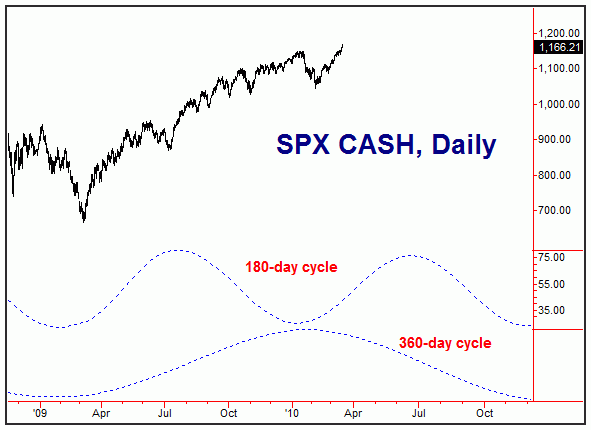
The 360-day cycle is now viewed as 260 days along - currently regarded as neutral to slightly bullish. Recent rotations of this wave have been averaging closer to 400 trading days. With that, it is next due to low-out around November of 2010 - which is also where the smaller 180-day wave is set to bottom.
Going back to May of 2009, this 360-day cycle had confirmed an initial upside target to the 965.93 - 1032.41 region; this projection was satisfied way back on 7/23/09. At the same that the first target was hit, the cycle then confirmed a secondary objective to the 1151.97 - 1263.45 range, which was finally met on 3/12/10 (last week). This cycle has now confirmed what should be a final upside target to the 1196.37 - 1314.05 level for the SPX. This same target ‘range’ also has the highest-odds of peaking this particular wave, key to note in the weeks and months ahead.
In taking a side look at some Elliott-Wave (which I like to do on longer-term timeframes), I currently see the move off the March, 2009 bottom as a very large ABC corrective rally, with wave ‘A’ of the move in progress - and with wave ‘B’ ending up as the next 180/360-day combination low, ideally made on or around November of this year (plus or minus). That decline should retrace 38-50% of the move from the 666.79 low to whatever high that ends up being seen on the current upward phase. Take a look at the following chart:
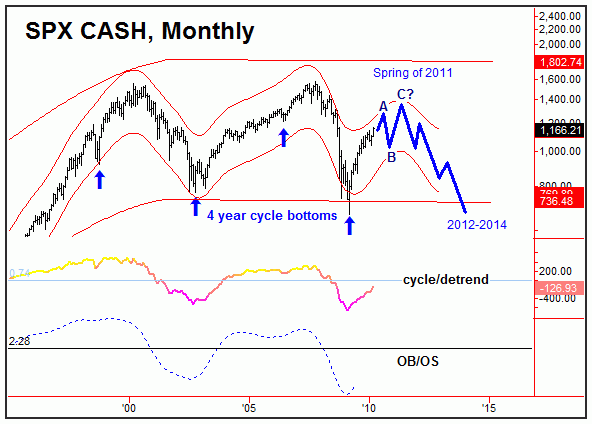
Once the 180/360-day cycles bottom out in the Autumn months, then a ‘B’ wave decline should give way to a final ‘C’ wave to the upside into the Spring of 2011. An added influence to the upward phases of these waves will be the ‘presidential cycle’ - which tends to low-out in the fourth quarter, before turning solidly higher into the following year (2011).
If all of the above does play out as noted for the bigger picture, a Spring, 20011 peak would top both the 360-day and 4-year cycles - and would then set the index up for a sharp five-wave decline into the 2012-2014 timeframe, where the combination of the larger 4 and 36 year cycles would then bottom-out. Although this is a high degree of speculation at the present time (I will have to make adjustments as we move forward), the above chart 'suggests' how the action could play out on a longer-term time scale in the next few years.
As far as technical action at the present time, both the advance/decline index and the McClellan Summation indexes have taken out their January peaks - which has confirmed the uptrend and also suggests higher price levels should continue to materialize in the weeks/months ahead. However, if we move into the Summer months and were to start seeing divergences in the same at that time, then we would have to be on the lookout for what could be a major top forming with the 180/360 day cycle components.
The technical state of the market is a good subject for a future article; stay tuned.
By Jim Curry
Market Turns Advisory
email: jcurry@cycle-wave.com
website: http://cyclewave.homestead.com
Jim Curry is the editor and publisher of Market Turns advisory, which specializes in using cyclical analysis to time the markets. To be added to our mailing list click HERE
Disclaimer - The financial markets are risky. Investing is risky. Past performance does not guarantee future performance. The foregoing has been prepared solely
for informational purposes and is not a solicitation, or an offer to buy or sell any security. Opinions are based on historical research and data believed reliable,
but there is no guarantee that future results will be profitable. The methods used to form opinions are highly probable and as you follow them for some time you
can gain confidence in them. The market can and will do the unexpected, use the sell stops provided to assist in risk avoidance. Not responsible for errors or
omissions. Copyright 1998-2010, Jim Curry
JIm Curry Archive
|
© 2005-2022 http://www.MarketOracle.co.uk - The Market Oracle is a FREE Daily Financial Markets Analysis & Forecasting online publication.



